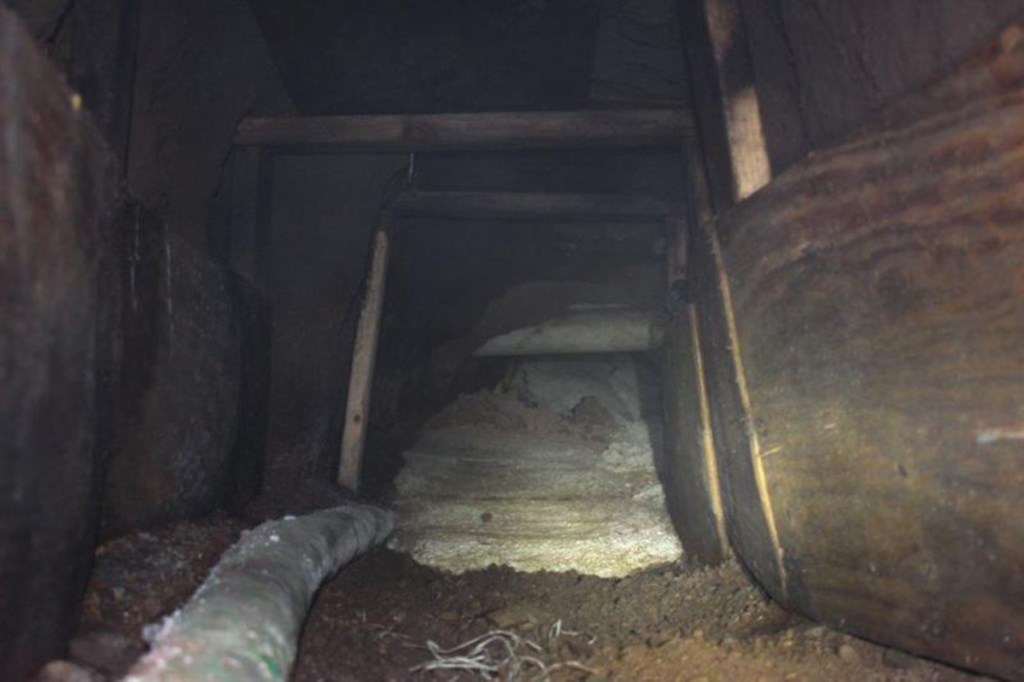One tunnel is about 50 feet long, unfinished, and stretches across two countries. It starts along the drainage channels that a U.S. border town shares with Mexico, and abruptly ends underneath a parking lot in Arizona.
Another one runs about 80 feet, also unfinished. Its opening was found inside an abandoned store in the Mexican border city of Nogales.
A third one is about 30 feet, also found somewhere in Nogales, though it’s unclear where it starts or ends.
These tunnels, which authorities suspect were built to smuggle illegal contraband or people across the border, were found just within the past month, as President Trump continues to demand $5.7 billion to build a border wall between the United States and Mexico. The stalemate over Trump’s signature campaign promise has resulted in what is now the longest government shutdown in the country’s history, leaving thousands of federal workers without pay.
The president has argued that building physical barriers would stave off illegal immigration and drug trafficking into the United States. But experts say these tunnels reaffirm a reality at the southern border: Drugs are trafficked into the country through multiple channels, including underground.
A physical barrier, whether it’s fencing, steel slats or a concrete wall, would keep out people who are willing to play by the rules. But for those who aren’t or can’t afford to, walls are mere temporary inconveniences, said David Shirk, an international relations professor at the University of San Diego.
“Whether we’re talking about drugs or people, where there’s a will, there’s a way to get around the wall. … These tunnels underscore the futility of the current debate in the fact that there will be numerous ways in which smugglers and undocumented persons will be able to breach the barriers that we build at the border,” Shirk said.
The recent discoveries are just among the latest. More than 200 tunnels have been discovered in the U.S. Border Patrol’s history.
Christopher Wilson, deputy director of the Mexico Institute at the Woodrow Wilson International Center for Scholars, said tunnels have been found in urban or suburban areas and usually enter or exit buildings in the United States. They’re built in areas where walls and fences, sometimes double or triple fencing, already exist, and more walls wouldn’t stop that, he said.
“The discovery of new tunnels reemphasize (the need) for a multi-prong strategy no matter what you’re doing,” Wilson said, citing investments in technology and staffing at ports of entry. “In terms of return on investment, $5 billion or $20 billion or $60 billion for a wall, it’s not going to give a good return on investment.”
Wilson said it’s difficult to ascertain what percentage of drugs come into the U.S. through tunnels. The majority of illicit drugs enter the U.S. through ports of entry.
Former associates of notorious cartel leader Joaquin “El Chapo” Guzman testified at his trial recently that they used tunnels to smuggle cocaine underneath the border between Mexico and Arizona for years, but they later began to find ways to transport drugs through ports of entry as law enforcement discovered these underground passages.
Some tunnels were short and still under construction when authorities found them. Some were bigger and longer, such as a 600-foot tunnel that was found in August under an abandoned KFC restaurant in San Luiz, Arizona, and another one found in October in Baja California in Mexico, just 200 feet south of the border.
Others were more sophisticated, such as a half-a-mile tunnel equipped with ventilation, rails and electricity, found in 2016 under San Diego and Tijuana. It’s the longest tunnel discovered so far.
The newly unearthed tunnels, all found near or along the two cities of Nogales – one in Mexico and one in Arizona – are rudimentary by comparison.
U.S. and Mexican officials have said little about the tunnels. The U.S. Customs and Border Protection has not responded to a request for comment. Officials at the agency’s Arizona office told the Arizona Republic that they have furloughed their media staff because of the ongoing government shutdown, and they’re unable to provide information.
Send questions/comments to the editors.


